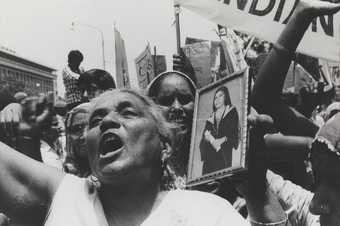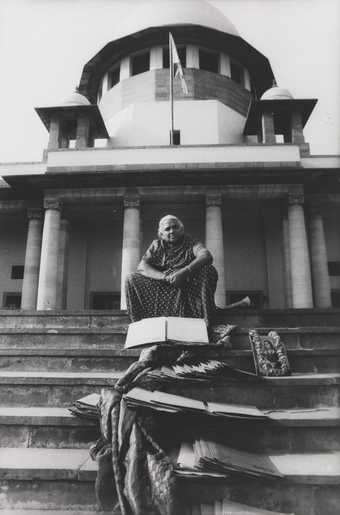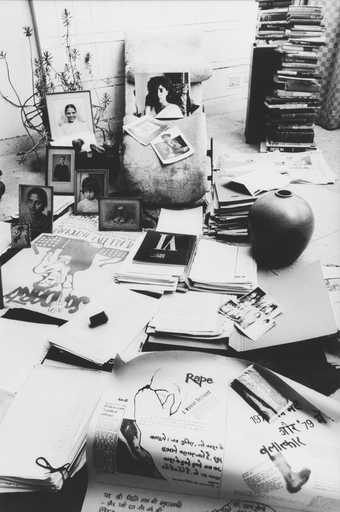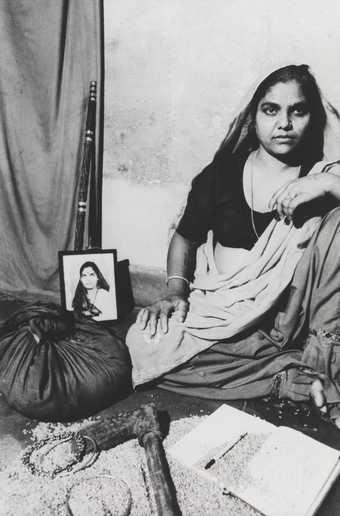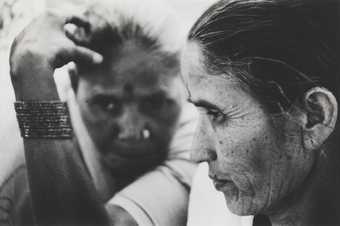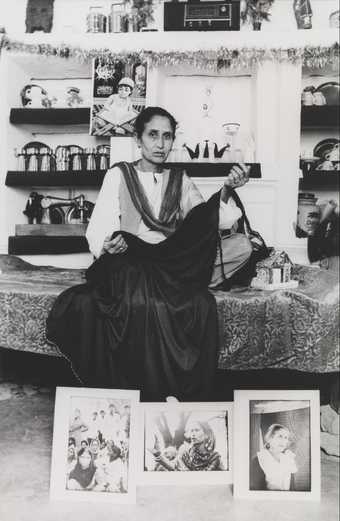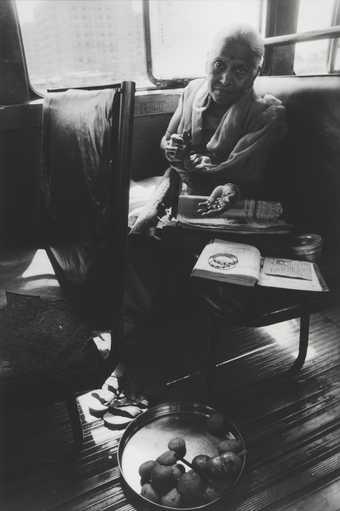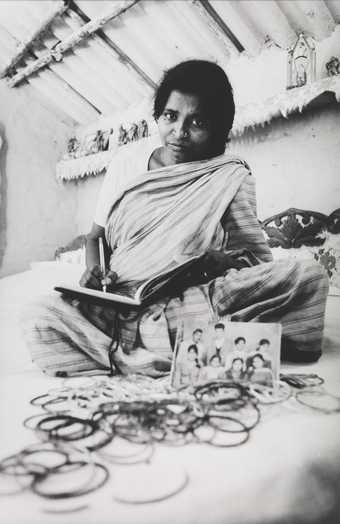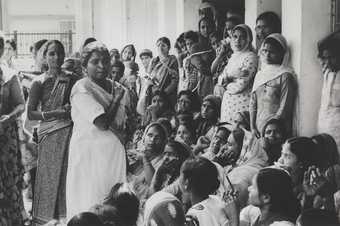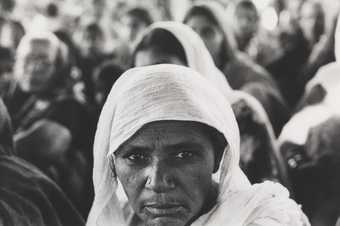
In Tate Britain
Prints and Drawings Room
View by appointment- Artist
- Sheba Chhachhi born 1958
- Part of
- Seven Lives and a Dream
- Medium
- Photograph, gelatin silver print on paper
- Dimensions
- Image: 381 × 568 mm
- Collection
- Tate
- Acquisition
- Purchased using funds provided by the South Asia Acquisitions Committee and Tate Members 2014
- Reference
- P81164
Summary
Seven Lives and a Dream is a group of nineteen black and white photographs (Tate P81156–P81174). They are digital prints produced in an edition of seven, of which these are number one, and were taken between 1980 and 1991 and printed in 2014. They include both staged and documentary images selected from a body of work by photographer and activist Sheba Chhachhi that spans decades of engagement with, and participation in, the feminist movement in India.
Chhachhi returned to her home town of Delhi in the early 1980s after studying at the National Institute of Design in Ahmedabad. The women’s movement in India had been galvanised after a notorious rape case in Delhi in 1978. Chhachhi’s sister was a founder-member of an activist group, and Chhachhi herself became involved both as an activist and a chronicler. Chhachhi’s images became a record of the struggle and were used for posters and pamphlets on issues such as dowry, as well as for street theatre and protests.
The feminist movement spanned class boundaries, and Chhachhi decided to re-examine her role and the power dynamics involved in her representation of the women whose personal struggles she had witnessed and supported. For Seven Lives and a Dream, Chhachhi reshot individual portraits of a select group of women, asking each to take control of the process and decide how they wanted to be portrayed, and encouraging them to choose objects of personal value to develop a more complex and staged image. Chhachhi has called this ‘an invitation to perform the self’ (Sheba Chhachhi, unpublished artist’s statement sent to Tate curator Nada Raza, June 2013). The power of the gaze, acts of representation and questions of agency or individual choice are central to gender politics. Curators Devika Daulet-Singh and Luisa Ortínez Díez have described how Chhachhi translates these concepts in Seven Lives and a Dream, ‘wherein the act of looking and the act of posing are negotiated to create a more equitable symmetry of power’ (Devika Daulet-Singh and Luisa Ortínez Díez, ‘An Introduction’, in Ananth, Bartholomew, Daulet-Singh and Ortínez Díez 2009, p.210).
The original invitation was extended to eight women but only seven participated, and the word ‘dream’ in the title refers to the absence of the eighth woman, although it is also suggestive of the women’s collective struggle for emancipation. This selection of nineteen images from the reconfigured portraits is intended for display as a group in a series of clusters, each dedicated to one of the women. Only the sitters’ first names are used in the titles – a feminist refusal of markers of patriarchy. Sathyarani carries a graduation photograph of her daughter, who was lost to a dowry killing. She poses in her home, and then outside the courts where she continued her fight. Radha is portrayed at home, surrounded by books and feminist literature, wearing riot-gear footwear under her saree. Urvashi similarly sits among her typewriters and is seen acting in a street play. Shanti has an image of her younger, more innocent self and looks to the future, a pen and paper in front of her.
The images were first exhibited in 1988 and according to Chhachhi they were ‘widely used and published in the context of the movement … in community centers and conferences and women’s day celebrations’ (Chhachhi 2013). Chhachhi has described her socially engaged photographs as portraits that move between ‘the representation of politics and the politics of representation’ (quoted in Ananth, Bartholomew, Daulet-Singh and Ortínez Díez 2009, p.234). Chhachhi knows each character’s story well and her empathy and affection is evident in these images, making Seven Lives and a Dream a testament to the legacy of the women that pioneered the feminist movement in India.
Further reading
Deepak Ananth, Pablo Bartholomew, Devika Daulet-Singh and Luisa Ortínez Díez, The Self and the Other: Portraiture in Contemporary Indian Photography, exhibition catalogue, La Virreina Centre de la Image, Institut de Cultura, Barcelona, and Artium, Vitoria-Gasteiz 2009, pp.208–11, 234.
Nada Raza
April 2013
Does this text contain inaccurate information or language that you feel we should improve or change? We would like to hear from you.
Display caption
This series includes both staged and documentary images. Chhachhi selected them from a body of work that records her long-term engagement with the feminist movement in India. Chhachhi’s images were used in posters, pamphlets and street theatre campaigns to end violence against women. In 1990 she reshot portraits of fellow activists taken years earlier. She encouraged the sitters to pose with objects of personal value. Chhachhi calls this ‘an invitation to perform the self’. She saw this collaboration as a way of redressing ‘the balance of power’ between artist and sitter.
Gallery label, December 2019
Does this text contain inaccurate information or language that you feel we should improve or change? We would like to hear from you.
You might like
-
Sheba Chhachhi Sathyarani - Anti Dowry Demonstration, Delhi
1980, printed 2014 -
Sheba Chhachhi Sathyarani - Staged Portrait, Punjabi Bagh residence, Delhi
1990, printed 2014 -
Sheba Chhachhi Sathyarani - Staged Portrait, Supreme Court, Delhi
1990, printed 2014 -
Sheba Chhachhi Radha - Staged Portrait, Anandlok, Delhi
1991, printed 2014 -
Sheba Chhachhi Radha - Staged Portrait Set-up, Anandlok, Delhi
1991, printed 2014 -
Sheba Chhachhi Shanti - Staged Portrait, Dakshinpuri, Delhi
1991, printed 2014 -
Sheba Chhachhi Shahjahan Apa - International Women’s Day gathering, Dakshinpuri, Delhi
1980, printed 2014 -
Sheba Chhachhi Shahjahan Apa - Staged Portrait set-up, Nangloi, Delhi
1991, printed 2014 -
Sheba Chhachhi Shahjahan Apa - Staged Portrait, Nangloi, Delhi
1991, printed 2014 -
Sheba Chhachhi Shardabehn - Staged Portrait, DTC bus, Terminus, Delhi
1990, printed 2014 -
Sheba Chhachhi Devikripa - Staged Portrait, Seemapuri, Delhi
1990, printed 2014 -
Sheba Chhachhi Devikripa - Sit-in, Family Planning Centre, Nandnagari, Delhi
1988, printed 2014 -
Sheba Chhachhi Devikripa - Sikh widow, Trilokpuri
1987, printed 2014 -
Sheba Chhachhi Urvashi - Street play, ‘Om Swaha’, Mehrauli, Delhi
1982, printed 2014 -
Sheba Chhachhi Urvashi - Staged Portrait, Gulmohar Park, Delhi
1990, printed 2014

